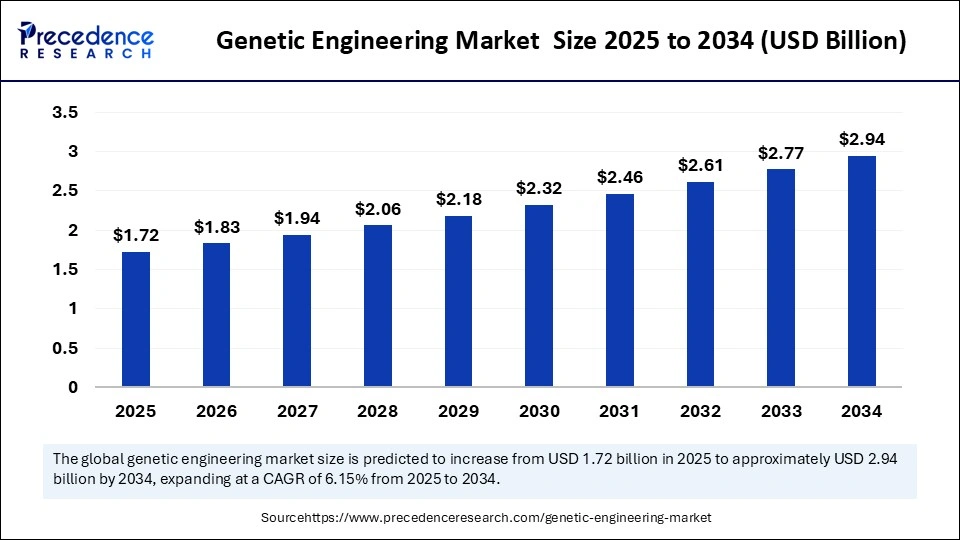 Genetic Engineering Market Key Takeaways
Genetic Engineering Market Key Takeaways- North America captured the highest share of the global market at 41% in 2024.
- Asia Pacific is anticipated to see the strongest growth during the forecast timeframe.
- Genetic markers led the product segment in terms of market dominance in 2024.
- The biochemical segment is poised for significant growth over the coming years.
- In 2024, PCR devices were the leading contributors by device type.
- The gene gun device is projected to grow at the fastest CAGR during the projection period.
- Gene splicing was the dominant technique in the market in 2024.
- Artificial selection is likely to exhibit the fastest technique growth over the next decade.
- The medical industry emerged as the top application segment in 2024.
- Agriculture applications are forecasted to grow swiftly from 2025 to 2034.
Market Overview
The genetic engineering market is transforming multiple sectors by enabling precise manipulation of genetic material to enhance traits, correct anomalies, and introduce novel functionalities. This market spans human therapeutics, agricultural improvements, and industrial applications such as biofuels and enzyme production.
Fueled by scientific innovation and the growing need for sustainable and personalized solutions, genetic engineering is becoming integral to the evolution of modern science and industry. Its expanding application landscape and the convergence of biology with digital technologies are setting the stage for a dynamic growth trajectory.
Drivers
Key drivers include the rising incidence of genetic disorders and cancers, the growing affordability of genetic testing, and an upsurge in demand for genetically engineered crops. The decreasing cost of DNA sequencing and synthesis has made genetic engineering more accessible to researchers and commercial entities.
Furthermore, government support through grants, tax incentives, and favorable policies in countries like the U.S., China, and Germany is encouraging the development of new genetic tools and applications. The biopharma sector’s dependence on genetically engineered organisms for biologics production is another vital growth engine.
Opportunities
Genetic engineering offers vast untapped potential in the area of synthetic biology, where scientists can design biological systems from scratch to perform specific tasks. This opens up possibilities in creating custom microorganisms for environmental cleanup, industrial manufacturing, and sustainable energy production.
In human health, there are expanding opportunities for genome-wide association studies and pharmacogenomics, which can optimize drug efficacy and safety. Agricultural biotech also remains a fertile ground, particularly with the development of crops that can grow in saline soils or require less fertilizer.
Challenges
Among the foremost challenges is navigating the complex ethical landscape surrounding gene editing, especially in human embryos and germline modifications. Public distrust, amplified by misinformation and cultural resistance, can hinder market acceptance and regulatory approvals.
The lengthy and costly clinical trial processes for gene-based therapies pose barriers to entry, especially for startups and smaller firms. Biosafety concerns and potential ecological impacts of genetically modified organisms remain under scrutiny, necessitating rigorous risk assessments and containment protocols.
Regional Insights
The genetic engineering market is geographically dominated by North America, with its robust biotech ecosystem and strong clinical research networks. Europe, though slightly more conservative in regulatory terms, remains a hub of innovation, especially in genome analytics and bioinformatics.
Asia-Pacific is making notable strides, with China leading investments in agricultural biotech and Japan advancing in precision medicine. Countries in Latin America are focusing on agricultural enhancements, particularly Brazil and Argentina, while African nations are exploring genetically engineered crops to combat food insecurity.
Recent Developments
Recent breakthroughs include the use of base editing and prime editing technologies, which allow for more refined and targeted genetic changes. Several startups and established firms are receiving funding to explore genetic engineering in regenerative medicine and microbiome-based therapies. There is also a growing emphasis on open-source genetic engineering platforms to democratize access to tools and data. In the industrial sphere, engineered microbes are being deployed to produce sustainable chemicals, offering an alternative to fossil-based manufacturing.
Genetic Engineering Market Companies
- Thermo Fisher Scientific Inc.
- Lonza
- Cibus
- Recombinetics Inc.
- Sangamo
- Merck KGaA
- Precision Biosciences
- OriGene Technologies Inc.
- Intellia Therapeutics Inc.
- Caribou Biosciences Inc.
Segments Covered in the Report
By Product
- Biochemical
- Genetic Markers
By Device
- PCR
- Gene Gun
- Gel Assemblies
By Technique
- Artificial Selection
- Gene Splicing
By Application
- Medical Industry
- Agriculture
By Region
- North America
- Europe
- Asia Pacific
- Middle East & Africa
- Latin America
